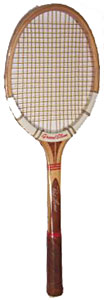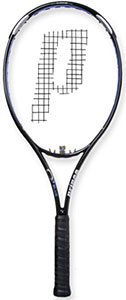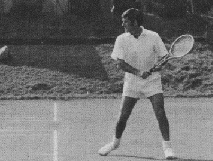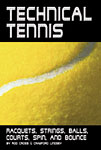|
TennisOne Lessons The Inch that Changed Tennis Forever
The modern game of tennis is played at a furious pace compared with the old days when everyone used wood racquets. Just watch old film from the 1950s and you will see that the game is vastly different. Ken Rosewall and Lew Hoad barely broke into a sweat. Today's game has players grunting and screaming on every shot, calling for the towel every third shot, and launching themselves off the court with the ferocity of their strokes. The difference is obviously due to the change from wood to graphite racquets, which happened during the late 1970s and early 1980s. Everyone concluded that graphite racquets were much stronger, lighter, and more powerful, while the players themselves somehow became taller, stronger and fitter. How else could the game have changed so drastically? The real reason for the change is more subtle. It's because racquets got wider. Wood racquets were always 9 inches wide and 27 inches long, so players could check the 36-inch height of the net by putting one racquet on top of another. Today's players can't do that. Most racquets are still 27 inches long, but they are now 10 to 12 inches wide. They are also lighter, which means they are less powerful, but it also means that players can swing them faster, which they need to do just to get back the power they lost when they became lighter.
When players started swinging their racquets faster, they noticed an interesting effect — they generated more topspin on the ball. A ball with topspin dives down more steeply into the court after it passes over the net compared with a ball without spin. Players noticed that the ball went in more easily, despite the fact that the ball was hit at about the same speed as with their old wood racquets. Not only that, the ball wasn't hitting the frame since they had an extra inch or two clearance to the frame. So what did they do next? They started hitting the ball even harder, which made the ball spin faster, and the ball still went in. Then they started swinging upwards at the ball to get even more spin, and they twisted the racquet in their hand to a Western grip to swing at even steeper angles to the ball. That grip gave them problems with their backhand, so they had to grip the handle with the both hands to tilt the frame back into a vertical position. The faster they hit the ball, the faster it spun, and the faster it spun, the harder they could hit it. That's why players today usually have both feet off the ground when they hit the ball, and it's why they need to grunt and curse and scream.
Players were given an inch in the 1970s and they took a mile. The ball now spins 4 or 5 times faster than it did before the 1970s. The amazing increase in spin is due to another subtle effect. When a ball bounces off the court, it spins at around 3,000 rpm, and it has topspin. To return the ball with topspin, the direction of spin has to be reversed. With an old wood racquet, players could change the spin by about 3,500 rpm by hitting the ball hard and by swinging the racquet upwards at about 20 degrees to the horizontal. That way, they could change the spin from 3,000 rpm backwards to about 500 rpm forwards. When wider graphite racquets became available, players could swing the racquet up at a steeper angle and tip it forwards about five degrees without the ball clipping the frame. That way, they could change the spin by about 4,000 rpm, from -3,000 rpm to +1,000 rpm, by swinging the racquet only slightly faster. In other words, players could immediately double the spin. It took them about 10 years to figure out the Western grip, but that allowed them to double the spin yet again. That's why players today rarely come to the net. They will more than likely see the ball spin over their head, down the line, or across the court at speeds and angles that were impossible 20 years ago.
Your comments are welcome. Let us know what you think about Rod Cross' article by emailing us here at TennisOne.
These and other question are addressed in this informative primer and will help turn hours of mindless practice into a focused application of principles affecting the impact, bounce, and flight of the ball. Further details are described in the new book "Technical Tennis: Racquets, Strings, Balls, Courts, Spin, and Bounce" by Rod Cross and Crawford Lindsey, $12.95, available from book store web sites or from the publisher. |



